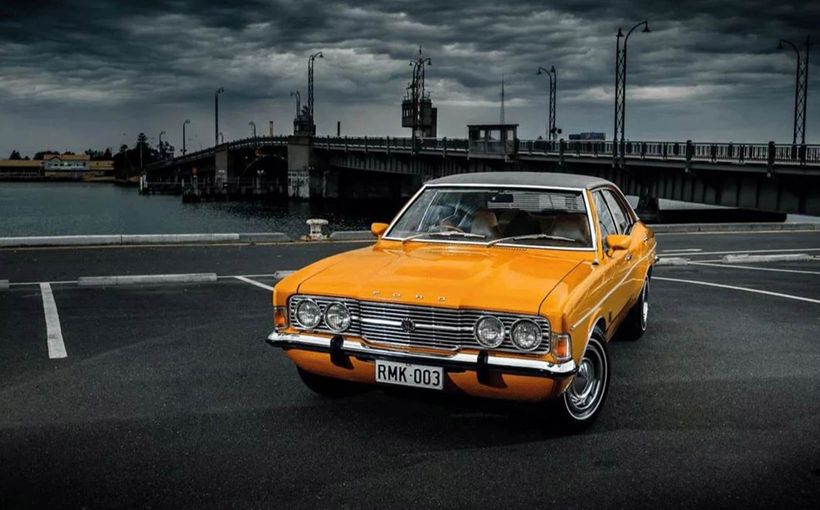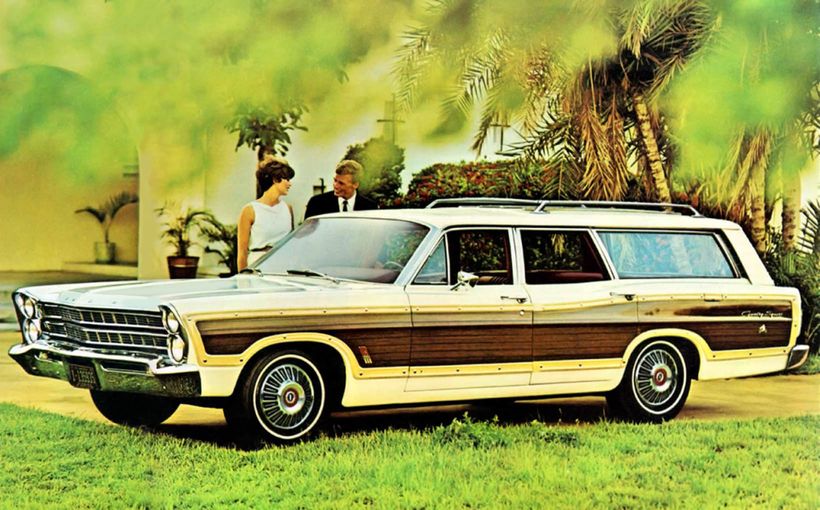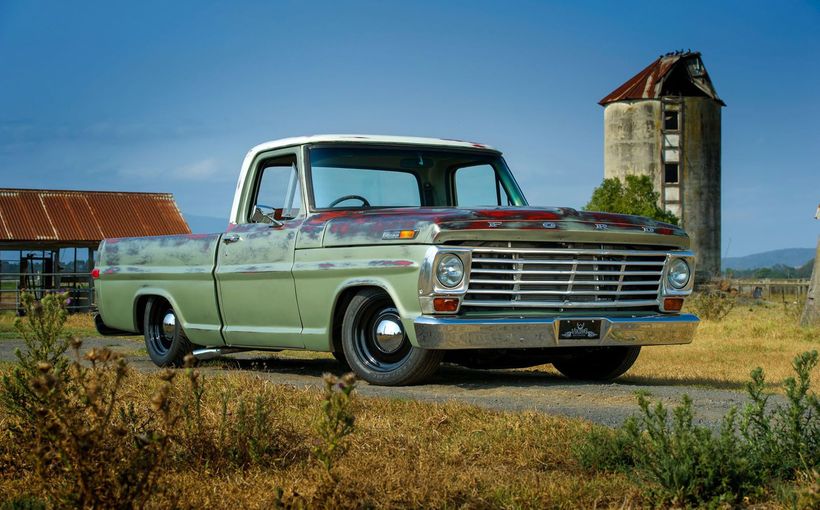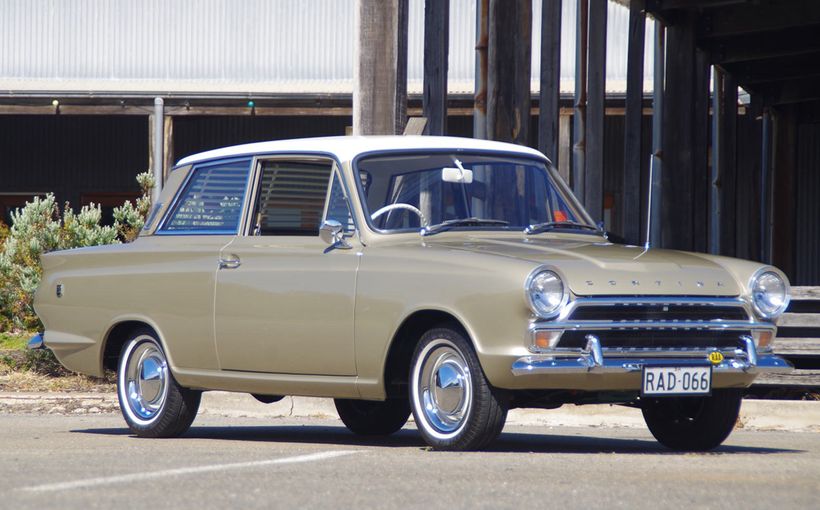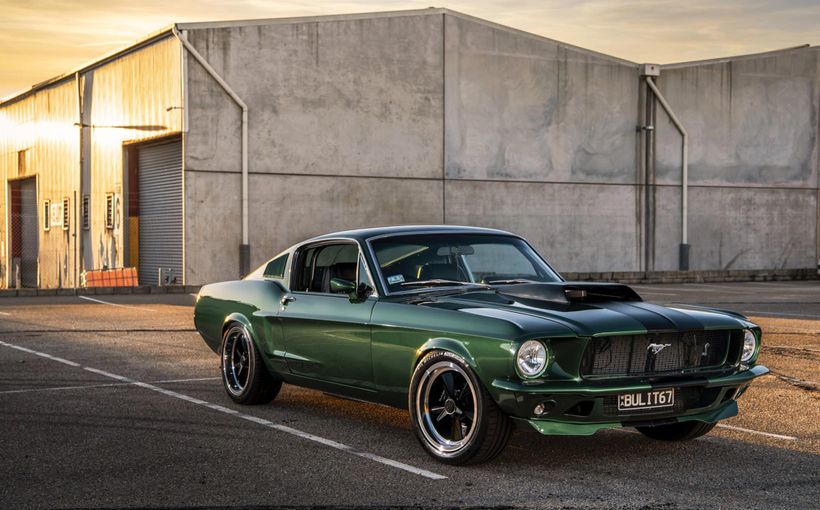EF and EL Falcons: Ford’s Mighty ATCC and Bathurst Champs

The EF and EL were the definitive models of the fifth generation Aussie Falcon and they certainly sent it out in winning style with two Australian Touring Car Championships and a Bathurst 1000 victory added to Ford’s bulging trophy cabinet.
The EF Falcon road car range was launched in August 1994 but the V8-powered sedan didn’t fire its first competitive shot until 1995, when it powered John Bowe to his first and only Australian Touring Car Championship title and a Sandown 500 victory with team boss Dick Johnson.
In a similar fashion, the EL Falcon was released in October 1996 but the V8 racing version did not debut until 1997, when Glenn Seton won his second Australian Touring Car Championship. And the following year, Jason Bright, Steven Richards and Stone Brothers Racing fought back from great adversity at Mount Panorama to win the 1998 Bathurst 1000.
The EF and EL models carried over a mechanical package established with the EB Falcon in 1993. That was when top level Aussie touring car racing underwent major change, with the axing of the turbo-dominated international Group A class in favour of a new set of home-grown rules that celebrated the long-awaited return of the Falcon V8.

The new category, which from 1997 was re-named V8 Supercars, was framed around Ford’s then current model EB Falcon and Holden’s VP Commodore, with each having theoretically a 50 per cent chance of winning.
Although it was touted as the return of the great ‘Aussie’ V8s, under those Falcon and Commodore bonnets were primarily US-sourced Ford and Chevrolet engines with a 5.0 litre (302cid) capacity limit, 7500rpm cap and 10:1 compression ratio to keep a lid on running costs. Power was estimated to be around 550 bhp (410 kW) with 450 ft/lbs (607Nm) of torque.
The gearbox mandated for use in both cars was a six-speed competition unit supplied by local race transmission guru Peter Holinger, feeding power to a multi-link live rear axle equipped with Ford’s ubiquitous nine-inch crown wheel and pinion.
Front suspension architecture had to remain faithful to the showroom product, with twin wishbones in the Falcon and MacPherson struts in the Commodore. A minimum racing weight of 1300 kg was imposed, which was later increased to 1350 kg.

Aerodynamic devices to generate downforce, in the form of a large front spoiler with an inverted wing or ‘under-tray’ and a large boot-mounted rear aerofoil, were mandated largely on safety grounds. Standard rolling stock was 17 x 11-inch wheels with 12-inch wide tyres.
Governing body CAMS put a caveat in the new rules that if either Ford or Holden displayed a consistent performance advantage it would make adjustments to maintain parity. The dreaded ‘p’ word would soon take centre stage in a decade-long political war of words between rival teams and manufacturers, as claims and counter-claims of inequality in parity adjustments created widespread ill-feeling for everyone involved.
Even so, this thundering new breed of Aussie V8 touring car was designed to deliver fast, loud and close racing. And the EB Falcon certainly grabbed a fair share of the early spoils for Ford, with Glenn Seton winning the 1993 ATCC before Dick Johnson and John Bowe teamed up to win a thrilling 1994 Bathurst 1000.

1995: The EF Goes Racing
The introduction of the EF Falcon to V8 Supercar racing in 1995 wasn’t too great a burden for Ford given that the changes were mainly cosmetic, with in most cases existing EB Falcons being updated with the latest EF front and rear panels.
The CAMS-approved front spoiler/under-tray and boot-mounted rear wing were reconfigured to suit the new shape and the car proved fast in pre-season testing. Arch rival Holden also updated its VP Commodore to the latest VR model, with similar cosmetic updates and aerodynamic adjustments to suit.
The main players in the Ford camp continued to be the Shell-backed Dick Johnson Racing from Queensland and the Melbourne-based Glenn Seton Racing backed by tobacco giant WD & HO Wills through its Peter Jackson brand (1995 was the last year of tobacco sponsorship of sport).
Dick Johnson and John Bowe were coming off a highly successful second half of the 1994 season in which they’d won the Sandown 500 and Bathurst 1000 double in their EB Falcon, while Glenn Seton and his 1980 F1 world champion team-mate Alan Jones were hungry for more success after their 1-2 finish in the 1993 ATCC.

To increase the chances of winning, Ford expanded its support from four to six cars. This included factory backing for former BMW and Ford Sierra star Tony Longhurst in a new EF Falcon on Yokohama tyres with Castrol sponsorship and another new EF for single-seater champion Mark Larkham also on Yokohamas and backed by the Mitre 10 hardware chain.
In 1995 the Falcon teams were also embroiled in a political storm which erupted just prior to the 1994 Sandown 500 when the CAMS National Eligibility Committee (NEC) ruled that Falcon body-shells being used by some of the top Ford teams did not comply with the category’s regulations. This controversy was explained in a detailed analysis I penned for V8X magazine in 2012:
“Ford was found to have produced body-shells and panels specifically for racing that were made from thinner gauge metal than standard. This weight saving extended to the windows, which were also found to have been made from thinner glass. The total weight saving as a result of these measures was believed to be around 35 kg.
“Ford’s former motorsport boss Peter Gillitzer had reportedly produced the special body-shells and panels because the Falcon (being heavier than the rival Holden Commodore) would have struggled to meet the category’s relatively low 1300 kg minimum weight limit.
“Under new racing manager Greg Harbutt, Ford had asked for clarification from the NEC on these lightweight shells as the issue boiled down to (as they always do) different interpretations of the rules.

“Ford argued that the body-shell of a race car was a ‘mechanical component’ but that argument was rejected by CAMS on the grounds that they were not the same specification as body-shells normally produced for Falcon road cars. Nor were they available to the general public.
“Harbutt said that the rules were very unspecific in that area and open to interpretation. In this case, the primary goal for Ford was in meeting the minimum weight for the class - how that was achieved was a secondary issue. As a result, the category’s weight limit was immediately increased from 1300 kg to 1350 kg in 1995 to remove the incentive for such measures.
“Despite widespread condemnations of Ford by Holden and its teams, the NEC would not call the lightweight shells ‘ineligible’ because of the huge damage such a ruling could have caused and the substantial costs it would have inflicted on teams in rectifying it. With no more to be built by Ford, CAMS planned to ID-tag the offending shells already serving race duties, to make sure they were indeed phased out over time.
“And to cool Holden tempers prior to Bathurst, CAMS also ruled that Ford teams running the lightweight Falcon shells would have to fit heavier standard-gauge hanging panels and window glass, plus carry a lump of ballast in the front passenger foot-well to restore their correct ‘road’ weight from then on.”

Even so, the EF Falcon proved to be a very fast and consistent race car, particularly the No.18 Shell-backed DJR version driven by John Bowe and engineered to perfection by the combined talents of Kiwi brothers Ross and Jim Stone. Bowe claimed an incredible eight pole positions from 10 rounds plus four round wins to secure his first ATCC in what had been an intense season-long battle with his Ford arch rival Glenn Seton.
What made Bowe’s victory even more rewarding was that his supply of Dunlop race tyres (Seton ran Bridgestones) had been threatened by a severe earthquake in Japan which destroyed Dunlop’s factory in Kobe. Dedicated staff dug deep into the rubble to extract several sets of Bowe’s prized race-winning tyres still in their protective wrappers and airfreighted them to Australia to keep his ATCC campaign on track. It was a remarkable effort by all and Bowe thoroughly deserved his crown.
As a result of Ford’s dominance of the ATCC, Holden teams demanded an adjustment under the parity rules to take the edge off the EF Falcon’s speed prior to the all-important Sandown 500 and Bathurst 1000 enduros.
The Falcon’s downforce-producing front under-tray was shortened by a substantial 200mm prior to Sandown. Ford drivers complained that the loss of front downforce had resulted in substantial understeer, but their concerns largely fell on deaf ears after EF Falcons finished 1-2-3-4 in the race!

Although Holden young gun Craig Lowndes claimed pole position at Bathurst in his HRT Commodore, the top Ford teams (aided by problems for HRT and Perkins) overcame their enforced handling deficiencies in the race. By half distance John Bowe and Glenn Seton were locked in a nose-to-tail battle for the lead which ended in grief when the two Falcons collided at Reid Park and sent Bowe nose-first into the concrete wall. He limped the twisted, smoking wreck back to the pits but the damage proved terminal.
Following that incident the bitterness between the two top Ford teams had never been greater as Seton closed in on his first long-awaited Bathurst win, driving car No.30 in the same year he turned 30 which was also 30 years after his father Bo had won the race. It seemed all the planets had finally aligned for the best driver yet to win it.
However it was not to be after a broken valve spring in the closing stages handed victory to the Larry Perkins/Russell Ingall Commodore and left Seton stranded on the Mountain with a dead engine just nine laps short of the finish. And things were going to get even tougher for Seton as 1995 was the last year of tobacco sponsorship in Australian sport.

1996
The second year of EF Falcon versus VR Commodore warfare saw Holden’s talented young gun Craig Lowndes come of age, when he was granted a full-time drive alongside Peter Brock with the Holden Racing Team at a time when the factory squad was also hitting its straps. As a result, Lowndes and HRT dominated the 1996 ATCC, winning six of the 10 rounds.
Johnson and Bowe returned in a pair of Shell-backed EF Falcons, but with the loss of his tobacco money Seton’s team had been reduced to one car for 1996 with new backing from Ford Credit.
Seton’s former team-mate Alan Jones had joined forces with DJR’s former engineering gurus Ross and Jim Stone to set up a new Queensland-based two-car Falcon team called Pack Leader Racing with backing from Ford and former tobacco sponsor Philip Morris.
However, none of the corporate giant’s numerous consumer brands were displayed on the cars which raised more questions than answers as to what benefits such a mysterious arrangement could deliver for the so-called ‘sponsor’. Not surprisingly, it lasted for only one year before new management shut it down.

It was also not a good season for defending ATCC champ John Bowe, after he and race leader Lowndes at the Philip Island round speared off the circuit at high speed after losing grip in damp conditions. Both drivers had big accidents, but Bowe’s was the worst of the two after his EF Falcon dug into the boggy outfield and flipped into a series of terrifying barrel-rolls which destroyed his 1995 championship winner and left Bowe with internal injuries that took a considerable time to heal.
Lowndes and HRT’s dominance of the ATCC brought swift action against Holden by the parity police prior to the Sandown 500, in the same way they had acted to slow down the EF Falcons the previous year. The VRs were hit with a 125mm reduction in the length of their front under-trays.
Even so, Lowndes and his gun Kiwi co-driver Greg Murphy still stormed to victory at Sandown ahead of Seton’s EF Falcon after a thrilling late race duel. Holden’s dynamic duo repeated the dose at Bathurst claiming pole position and a convincing victory after 1000km. The youth revolution in touring car racing had begun.

1997
The EF Falcons were updated to the latest EL model which again was a simple cosmetic alteration of bodywork as the basic mechanical package established with the EB in 1993 was unchanged. Holden’s update to the latest VS model Commodore was just a rubber-stamping exercise as there were no cosmetic changes needed.
Holden’s reigning champion Craig Lowndes did not defend his ATCC title in 1997 as he had moved to the UK to try his hand at Formula 3000 as a possible stepping stone to Formula One. His replacement at HRT was logically his 1996 Sandown/Bathurst team-mate Greg Murphy alongside the retiring Peter Brock.
The 1997 ATCC was another intense Ford vs Holden battle fought over 10 rounds and the ‘new’ EL Falcon proved just as competitive as its EF predecessor. Proof of the evenly-matched competition between the top Ford and Holden teams was that four drivers (Seton and Bowe for Ford, Ingall and Perkins for Holden) went into the final round at Sydney’s Oran Park with a mathematical chance of winning the championship.

Seton in his Ford Credit-backed EL Falcon did the best job of the four protagonists, finishing second to race winner Greg Murphy to secure his second national touring car title.
As both sides prepared for the annual Sandown 500 and Bathurst 1000 clashes, Lowndes returned to his seat at HRT after a disappointing open-wheeler debut season in Europe which determined that his immediate future was in V8 Supercar racing with Holden.
Multiple touring car champion Mark Skaife also joined HRT as co-driver to the retiring Peter Brock at Sandown and Bathurst, claiming pole position at both races in the ‘05’ Commodore but retiring from each due to mechanical gremlins. Skaife then replaced Brock full-time in 1998.
The leading EL Falcon teams were also out of luck, with the reunited Murphy/Lowndes HRT combination winning the Sandown 500 before Larry Perkins and Russell Ingall co-drove to a second Bathurst 1000 win in three years in their Castrol Commodore.

1998
This was the last year that the major Ford and Holden teams raced EL Falcons and VS Commodores. Holden debuted its all-new fifth generation VT Commodore in later rounds of the ATCC with Ford’s much anticipated (but ultimately disappointing) all-new AU Falcon making its racing debut the following year.
The HRT and Castrol-Perkins VS Commodores showed enough of a speed advantage over the EL Falcons in the early rounds of the ATCC for the Performance Review Committee to take action. However, after being conned by Holden representatives in the supposedly impartial and scientific track testing that took place, the PRC’s mid-season parity adjustment was farcical.
The VS Commodores were required to lose just 2.0 mm from the height of the Gurney flaps on their boot-mounted rear wings. No surprise that this laughable ‘finger nail clip’ produced no discernible change in performance parity.
The red-faced PRC acted again on Ford’s behalf prior to the debut of the all-new HRT and Castrol-Perkins VT Commodores with their equally new aerodynamics in round eight at Calder Park. The EL Falcon was given an aero update with a more efficient ribbed front under-tray and raising of the rear wing by 53mm to get it up into cleaner air flow to improve rear downforce.

Even so, Lowndes romped away to his second ATCC title in three years, driving the new VT Commodore in the closing rounds as planned. The EL Falcon won only one round that year, thanks to John Bowe’s efforts in his final season with DJR.
The new VT was clearly a fast race car straight out of the box, presenting Ford teams with an ominous task at the Sandown 500 and Bathurst 1000. Holden drew first blood when Perkins and Ingall drove to a well-judged win at Sandown in changeable weather conditions.
However, Ford struck back at Bathurst with a victory against the odds by the Stone Brothers Racing (SBR) EL Falcon shared by young guns Jason Bright and Steven Richards. After Bright slapped a concrete wall hard during practice, the SBR team repaired the heavily damaged Falcon and played a clever out-of-sequence race strategy which resulted in Richards being in second place and ready to pounce when the leading Lowndes/Skaife HRT Commodore suffered a tyre failure with less than 50 laps remaining.
Richards immediately surged into a race lead that would build to a comfortable 10-second winning margin when the chequered flag fell. Ford could not have asked for a better finale for the EL Falcon which went out a Bathurst winner.



